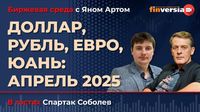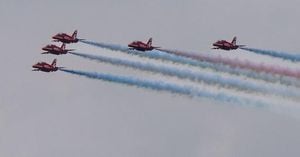The Russian ruble is experiencing significant depreciation, driven by deteriorating geopolitical conditions and investor sentiment. On April 23, 2025, the ruble weakened against major currencies, reflecting the market's reaction to uncertainty surrounding peace negotiations between Russia and Ukraine.
At 17:55 Moscow time, the yuan/ruble exchange rate was approximately 11.40, marking a 2.4% loss for the ruble. The dollar was trading at 83.35 rubles, representing a 2.2% decline, while the euro was at 94.74 rubles, down by 1.8%. This marks the worst performance for the ruble since the end of March.
According to the Central Bank of Russia, the official exchange rates set for April 23, 2025, reflect this weakening trend: 11.34 rubles per yuan, 82.36 rubles per dollar, and 94.57 rubles per euro. Analysts attribute the ruble's decline to a shift in market sentiment following news that planned negotiations between the U.S., EU, and Ukraine in London may be less productive than anticipated.
Market participants are now minimizing risks and partially closing previously established long positions on the ruble. This shift comes in the wake of increased uncertainty about achieving a peace deal, which no longer appears to be a quick process, despite optimistic comments from U.S. President Donald Trump just days earlier.
Vladimir Chernov from Freedom Finance Global noted that the heightened likelihood of the U.S. exiting the peace negotiations is a significant negative factor for the ruble's valuation. He highlighted that the potential for sanctions to remain in place further complicates the outlook for the Russian currency.
On April 23, the ruble also faced pressure due to discussions around adjustments to the budget rule proposed by Finance Minister Anton Siluanov. A lower oil price threshold could lead the government to purchase more foreign currency to replenish the National Wealth Fund, further weakening the ruble.
Despite these challenges, the ruble has shown remarkable growth since the beginning of the year, up 35% against the dollar and 21% against the yuan, buoyed by improved geopolitical conditions following the Republican administration's arrival in the U.S. and hopes for an end to the Russian-Ukrainian conflict.
Recent trading sessions saw the ruble testing highs not seen since June of the previous year, with rates reaching 80.35 rubles per dollar and 10.96 rubles per yuan. However, local support for the ruble is minimal, primarily driven by exporters preparing for upcoming monthly tax payments and daily currency sales by the Central Bank.
The Central Bank of Russia has maintained a high key interest rate of 21% per annum, a factor that has provided some support for the ruble. A Reuters poll indicates that the Central Bank is likely to keep the key rate unchanged on April 25 due to slow inflation and new external risks, such as trade wars, necessitating cautious monetary policy.
In the realm of trading strategies, experts emphasize the importance of technical analysis in navigating these turbulent market conditions. Successful traders do not rely solely on fundamental analysis but incorporate technical indicators to make informed predictions. Technical analysis allows traders to identify patterns and trends in market data, which can lead to more accurate forecasting.
This dual approach—combining fundamental insights with technical analysis—enables traders to gauge market dynamics and investor behavior effectively. Understanding these elements is crucial, especially in times of geopolitical uncertainty.
As the situation continues to evolve, traders and investors alike will be closely monitoring developments in the Russia-Ukraine negotiations, as well as the broader geopolitical landscape. The interplay between market sentiment and economic indicators will remain a focal point for those engaged in currency trading.
In conclusion, the ruble's recent decline underscores the intricate relationship between geopolitical events and market performance. As traders adapt their strategies in response to changing conditions, the importance of a comprehensive analytical approach cannot be overstated.




